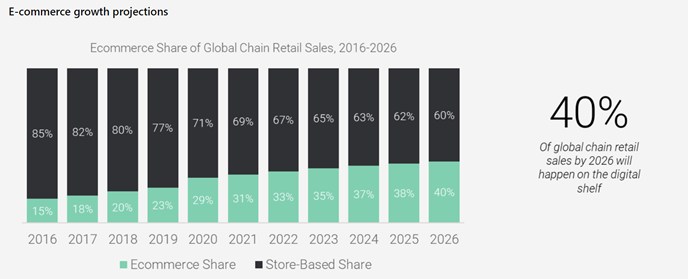Planning for ecommerce part 1: Optimising stage one of the online shopper journey
The explosion in ecommerce and digital channels in recent times has raised expectations on retailers when it comes to their online shopping experience. More customers are shopping online more often, and they want a seamless, personalised experience when doing so. But how can grocers add value through personalisation, at scale, without heavily discounting products? A new video series from dunnhumby shows some of the ways we can support.
The online explosion
There is no doubt that the pandemic accelerated the shift to online grocery shopping. In the dunnhumby Global Consumer Pulse Survey conducted during the height of COVID-19, nearly two thirds (60%) of global customers said they shop more online than they did pre-pandemic. To reinforce this finding, the ecommerce share of global chain retail sales rose from 23% in 2019 to 31% in 2021, with further growth expected in the coming years according to Edge by Ascential (Figure 1).

Figure 1: Ecommerce share of global chain retail sales, 2016 – 2026. Source: Ascential Edge
This sustained growth in grocery ecommerce has increased pressure on retailers to develop and enhance their online channels and do so profitably. How do grocery retailers find the right mix of products, promotions, rewards, and delivery options to delight customers and create an engaging shopping experience that ensures they are driving revenue in increasingly competitive ecommerce markets? One part of the solution is personalisation.
The shift in personalisation has been seismic. Five years ago, it was a real standout feature, available only to those with the budgets to invest in data collection and segmentation. Now, it’s an expectation, particularly with greater awareness of data handling. The key for retailers is to ensure they are in a position to be maximising personalisation at scale.
“Some traditional, regional grocers have proven they can fight back (against digital leaders like Amazon, Walmart and Target) with either a personalised, omnichannel fulfilment experience or personalised, omnichannel offers and rewards. Rich customer data and the ability to action on it is the important asset here. The long-term war for omnichannel supremacy will be in omnichannel personalisation and not just ecommerce purchasing.” dunnhumby North America Ecommerce Retailer Preference Index, 2021
Creating a personalised, omnichannel experience
To demonstrate the power of personalisation, dunnhumby has created a new three-part video series exploring some of our solutions that help retailers build an always-on, personalised, omnichannel customer experience.
Focusing individually on the three key phases of the online customer journey – plan, shop, buy – we’re showing how retailers can deliver the personalised experience customers expect, and maximise value in doing so. All using dunnhumby propositions that deliver incremental revenue without simply heavily discounting products.
Phase 1: Plan
When a customer is planning their next shop, they expect that the promotions they engage with will be tailored to their individual needs. Even before the customer starts their shop online (or in store), therefore, retailers need to be delivering the right offers and content to customers via their preferred channels, at the right time.
Using insights from shopper behaviour, dunnhumby’s ‘Personalised Offers’ proposition helps retailers to meet this expectation for a personalised experience, on a large scale.
Providing a one-to-one curated selection of offers, Personalised Offers can be sent in an email, delivered on a retailer’s website, app or even via chatbot. These personalised incentives can improve price perception by rewarding customers with incremental discounts on products they buy most often, whilst encouraging them to buy more for increased basket spend.
And personalisation matters – customers say they are 110% more likely to add additional items into their basket if the shopping experience was highly personalised and 40% more likely to spend more than they had planned, according to BCG. Research by Salesforce shows 52% of customers are likely to shop elsewhere if a company fails to personalise their messaging to them.
Sending personalised offers proactively (for example via email) also ensures that the retailer is front of mind, resulting in repeat visits and sales. It is no surprise that customers will choose a retailer again and again if they make it easy for them to plan and it also drives loyal customer retention over time and/or customer lifetime value.
Crucially, in a challenging market where margins are inevitably being squeezed by external pressures such as rising price inflation and supply chain issues, this proposition helps retailers deliver on the customer’s need for value, without giving away large discounts in extensive product ranges.
Giving customers the chance to earn and redeem (burn) their rewards discounts or points online, just like they would in store, creates a win-win scenario for all. The retailer benefits from repeat visits and sales, fuelled by loyal customer retention, and the customer benefits too – saving money on products they want, whilst being treated as an individual, and all as part of a seamless omnichannel experience.
In practice: Using Personalised Offers, one Northern European retailer achieved a 2% like-for-like sales uplift, with £13:1 redemption rate on offers and a 4:1 sales to cost ratio. All in just a one-year period.
Want to learn more? Find out more about Personalised Offers from dunnhumby.
Stay tuned for the next article exploring our video series on optimising the online shopper journey, when we’ll be covering Phase Two: Shop.
RELATED PRODUCTS
Truly understand your Customers and unlock your Customer First transformation with Strategy Development, Research & Insights and Organisation Engagement
Build a differentiated Customer strategyThe latest insights from our experts around the world
Understanding evolving customer needs in the age of AI and data abundance



